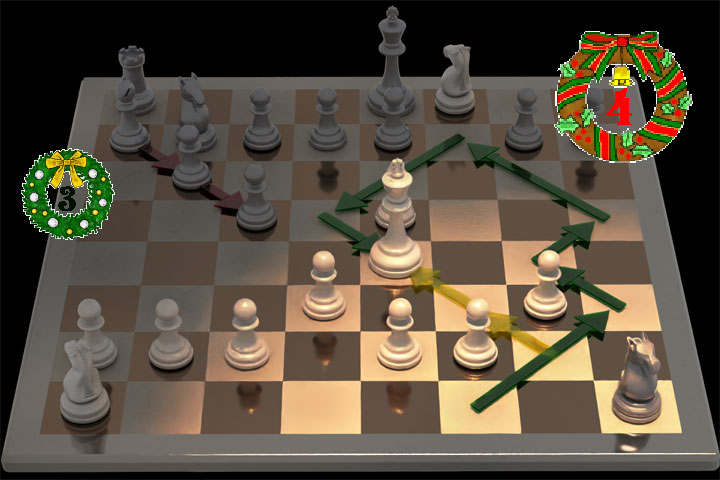


ChessBase 17 - Mega package - Edition 2024
It is the program of choice for anyone who loves the game and wants to know more about it. Start your personal success story with ChessBase and enjoy the game even more.
This was Anirudh's sound helpmate composition, which has only one solution. Remember, Black makes the first move. 1...g1R 2.f8B Rg8 3.Bxd6 Rd8 4.Ba6#
Pal Benkö, 2015

White to play and mate in five
Did you find the solution? 1.Bd5 Kxg6 2.Bd4 Kh7 3.Kf4 Kg6 4.Bg8 Kh5 5.Bf7 mate.
The Christmas Tree problems started with a direct mate:
Solution: 1. Ba5 Kd6 2.e5#
1...Kf6 2.Bc3#
1...Kd4 2.Nf3#
1...Kf4 2.Bc7#
Such a variety of different mates!
The next puzzle was shaped even more like a Christmas tree:
How can Black (to play) and White cooperate to get the black king mated in three moves? There are two solutions:
1.Qd5 Nh3 2.Ke5 Nxg5 3.Nf6 Nxf7#
1.Se7 Nh1 2.Rg6 Ng3 3.Bg5 Nh5#
Were the above two problems too easy? The following helpmate that is harder, especially the very deep question that is attached to it:
The solutions of the helpmates are:
1...O-O-O 2.Ng6 Bb8 3.Nxe7#
1...Kf7 2.Nxh7 Ke6 3.Ng5#
Normally it is fine for a helpmate to have two (very different) solutions. But one of the solutions is illegal. It requires deep retroanalytical reasoning to work that out. Here's the explanation provided by Anirudh Daga (warning: it might lead to spells of dizziness):
We know that the black bishop on a7 is promoted since from f8 it could not have escaped its barricades of e7 and g7. It must have been the f7-pawn that was promoted, and the only squares it could have happened would be on e1 or c1 since it could not have escaped from g1. The black pawn structure on the queenside could only have arisen through a7xb6xc5 to ensure the black bishop can reach a7 and thus we can account for altogether five captures made by Black, which are responsible for the missing five white pieces (QRRBS). Likewise, White has made three captures, which will be of the queen, rook and bishop.
Before Black plays b7-b6, all black captures must have been made since we know Ba7 is promoted. The question now remains as to where the white light-squared bishop would have been captured and we can safely presume that it must be e6 or e4 which the f7-pawn has taken. For the wP to reach e5, it must have captured a light-squared bB and thus the route must have been g2xf3xe4-e5 and h2xg3.
From this deduction, the bR must be captured on f3 since b7-b6 and the freeing up of the other two pieces that are captured only happens later. But the question now arises as to how the bishop was captured on e4 when the bP is on h7? It is simply not possible without giving check since the wB must go through f1-h3-g4-h5-f7-d5-e4 and evidently, the bK will have to move. Thus castling is not allowed in the diagrammed solution! So only the second solution is legal. Phew!
We left out one part of the problem: move the black pawn from h7 to h6 in the diagram position. In this case the bishop can go via g6-h7-g8 (with the knight on f7 to block the check) and thus can reach e4. In that case Black castling is possible, and the problem is a twin!
Have you enjoyed these puzzles? We hope it will encourage you to venture into the fascinating world of chess composition. Our competition for amateur composers will close on Janurar 15.
Please submit your compositions here
| Advertising |